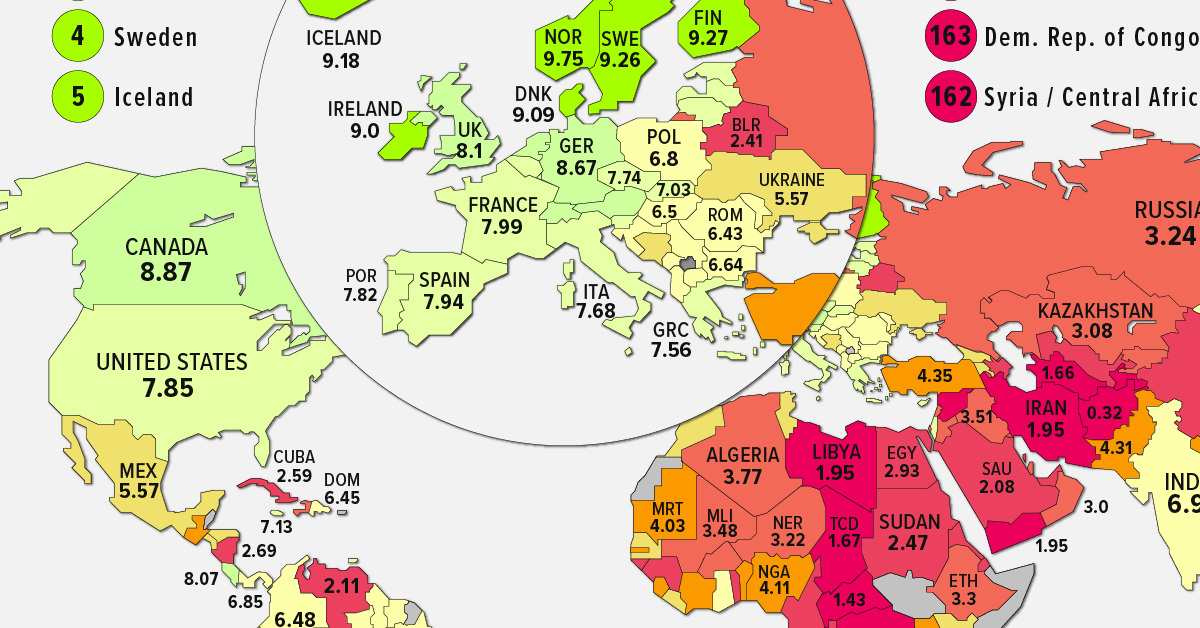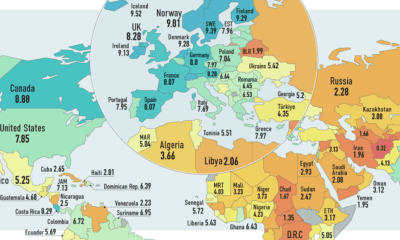Politics
Mapped: The State of Global Democracy in 2022
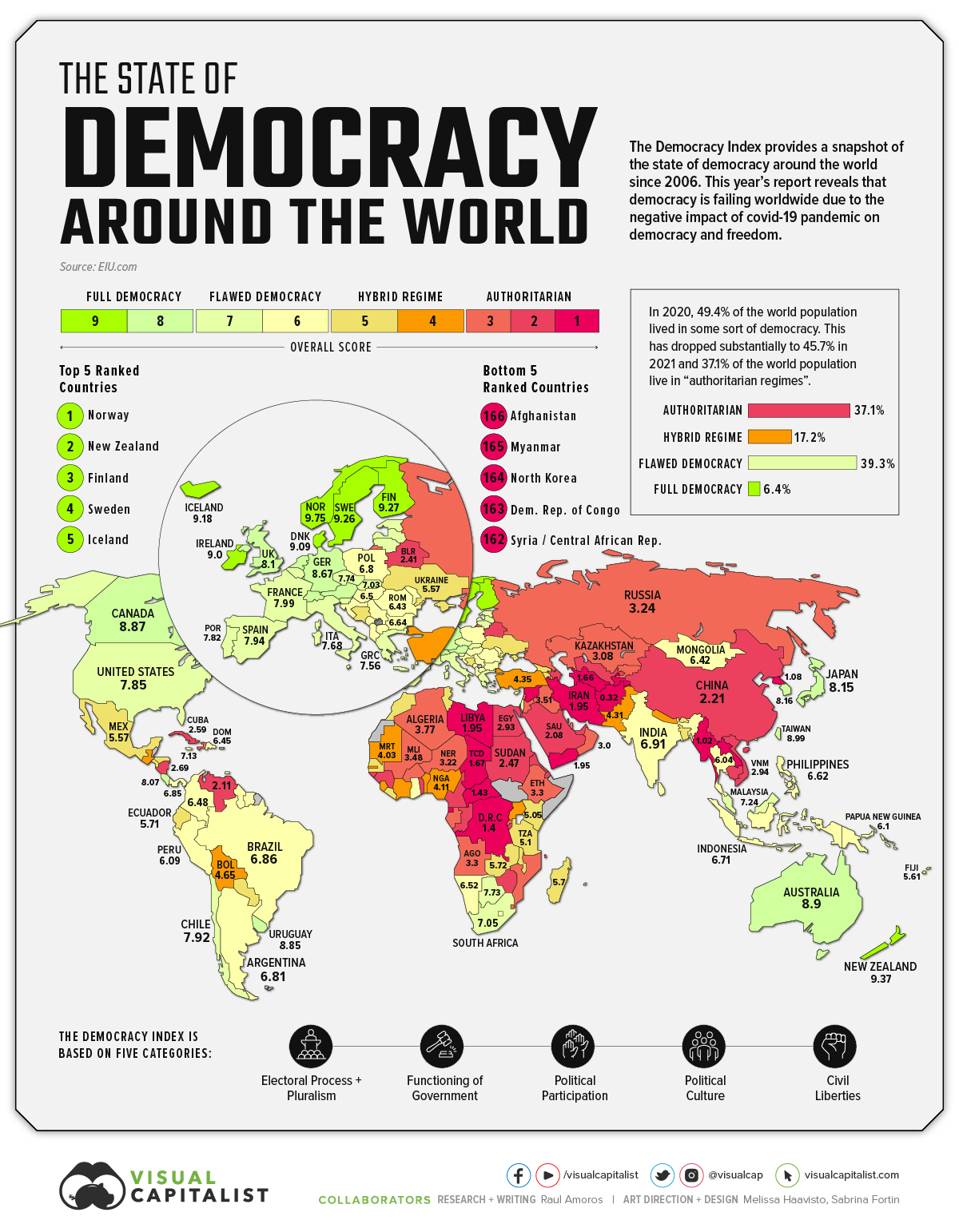
Mapped: The State of Democracy Around the World
The world’s (almost) eight billion people live under a wide variety of political and cultural circumstances. In broad terms, those circumstances can be measured and presented on a sliding scale between “free” and “not free”—the subtext being that democracy lies on one end, and authoritarianism on the other.
This year’s Democracy Index report by the Economist Intelligence Unit (EIU), is one such attempt to apply a score to countries based on how closely they measure up to democratic ideals.
According to EIU, the state of democracy is at its lowest point since the index began in 2006, blamed in part on the pandemic restrictions that saw many countries struggling to balance public health with personal freedom.
In this year’s report, the EIU reported a drop of the average global score from 5.37 to 5.28, the biggest drop since 2010 after the global financial crisis. This translates into a sobering fact: only 46% of the population is living in a democracy “of some sort.”
Let’s dive a bit deeper into what this means.
Percentage of Population by Regime Type
In 2021, 37% of the world’s population still lived under an authoritarian regime. Afghanistan tops this list, followed by Myanmar, North Korea, Democratic Republic of the Congo, and Syria. Of course, China has a big share of the population living under this style of regime.
On the other side of the spectrum we have full democracies, which only account for 6.4% of the population. Norway tops this list, followed by New Zealand, Finland, Sweden, and Iceland.
| Regime Type | No. of Countries | Share of countries | Share of World Population |
|---|---|---|---|
| Full democracies | 21 | 12.6% | 6.4% |
| Flawed democracies | 53 | 31.7% | 39.3% |
| Hybrid Regimes | 34 | 20.4% | 17.2% |
| Authoritarian regimes | 59 | 35.3% | 37.1% |
Let’s explore the characteristics of each of the four types of regime according to the EIU:
Full democracies are nations where:
- Civil liberties and fundamental political freedoms are respected
- Valid systems of governmental checks and balances exist
- There are limited problems in democratic functioning
- Media is diverse and independent
Flawed democracies are nations where:
- Elections are fair and free
- Basic liberties are honored but may have issues
- There are issues in the functioning of governance
Hybrid regimes are nations where:
- Electoral fraud or irregularities occur regularly
- Pressure is applied to political opposition
- Corruption is widespread and rule of law tends to be weak
- Media is pressured and harassed
- There are issues in the functioning of governance
Authoritarian regimes are nations where:
- Political pluralism is nonexistent or limited
- The population is ruled by absolute monarchies or dictatorships
- Infringements and abuses of civil liberties are common
- Elections are not fair or free (if they occur at all)
- Media is state-owned or controlled directly or indirectly by the ruling regime
- The judiciary system is not independent
- Criticism of the government is censored
Global Democracy Index by Region
As mentioned earlier, in 2021, the global democracy score declined from 5.37 to 5.28. This was driven by a decline in the average regional score, but every region has a different reality. Let’s take a look at the democratic state of each region in the world.
Americas
North America (Canada and U.S.) is the top-ranked region in the Democracy Index with an average score of 8.36, but this dropped significantly from 8.58 in 2020.
Both countries have dropped their positions in the global ranking, however, Canada still maintains the status as a full democracy.
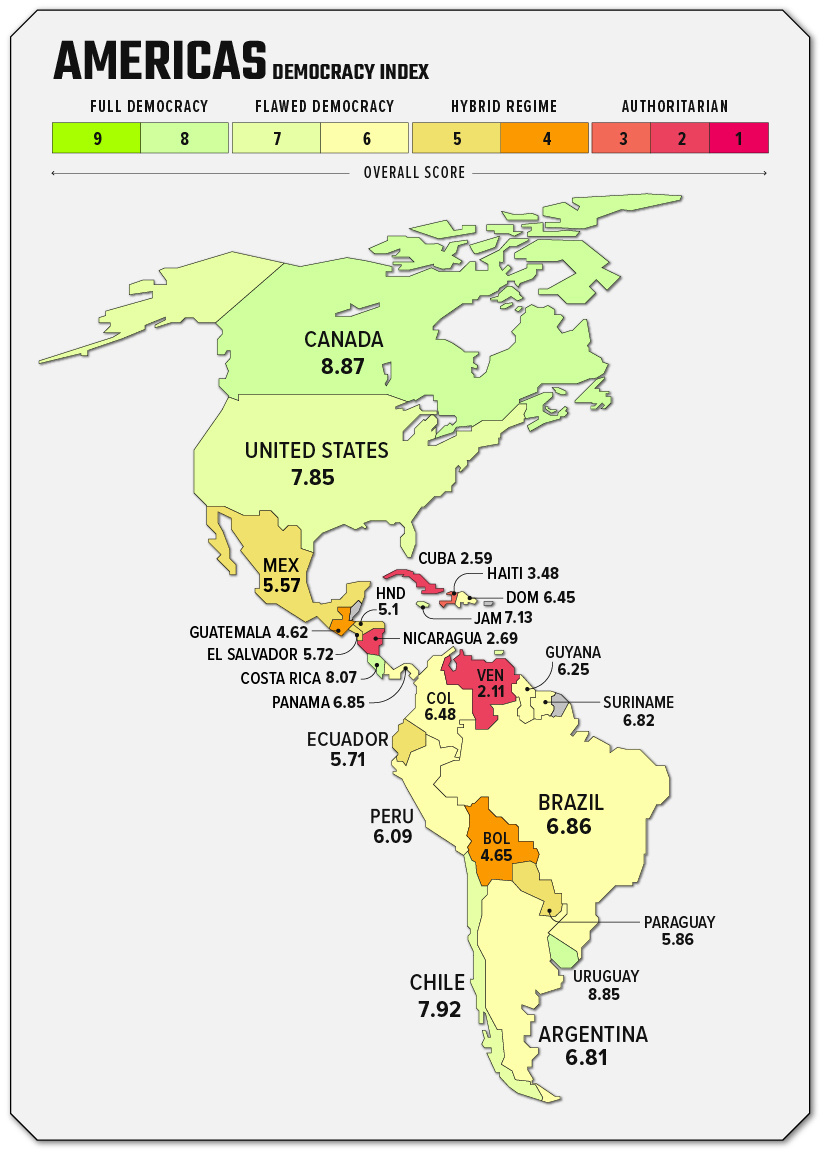
The U.S. is still classified by EIU as a flawed democracy, and has been since 2016. The report points to extreme polarization and “gerrymandering” as key issues facing the country. On the bright side, political participation in the U.S. is still very robust compared with the rest of the world.
Latin America and the Caribbean experienced the largest decline in regional scores in the world. This region dropped from 6.09 in 2020 to 5.83 in 2021. This decline shows the general discontent of the population about how their governments have handled the pandemic.
In this region, the only countries falling under the full democracy category are Costa Rica and Uruguay. On the other side of the spectrum, Venezuela, Nicaragua, and Cuba fall under the authoritarian regime classification.
Europe
In 2021, Western Europe is the region with the most full democracies in the world.
In fact, four out of the top five full democracies are in this region: Norway, Finland, Sweden, and Iceland. A notable downgrade in this region happened in Spain; the country is now considered a flawed democracy.
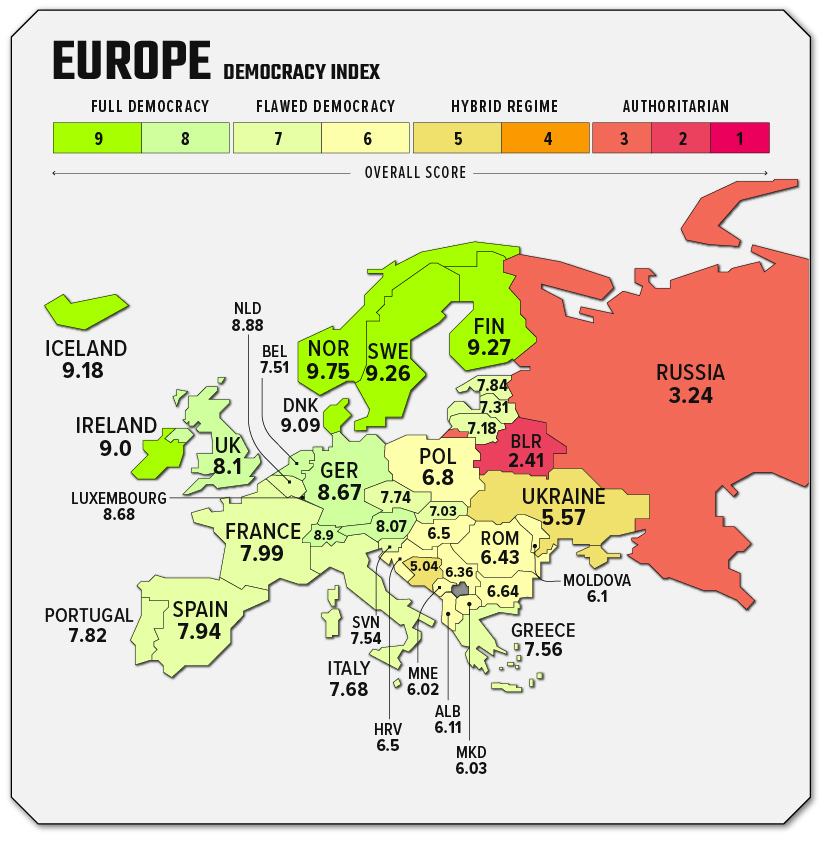
Eastern Europe paints a different picture, where there is not a single full democracy. Three countries (Moldova, Montenegro, and North Macedonia) were upgraded from being considered hybrid regimes to flawed democracies.
Ukraine’s score declined to 5.57, becoming a hybrid region. Russia’s score also declined to 3.24 keeping the authoritarian regime status. It’s important to note that this report by the EIU was published before the invasion of Ukraine began, and the conflict will almost certainly impact scores in next year’s report.
Africa
Sub-Saharan Africa has the most countries at the bottom of the Democracy Index rankings.
The fact is that 23 countries are considered “authoritarian regimes”. Meanwhile, there are 14 countries that are hybrid regimes, six countries under flawed democracy, and only one country, Mauritius, is considered a full democracy.
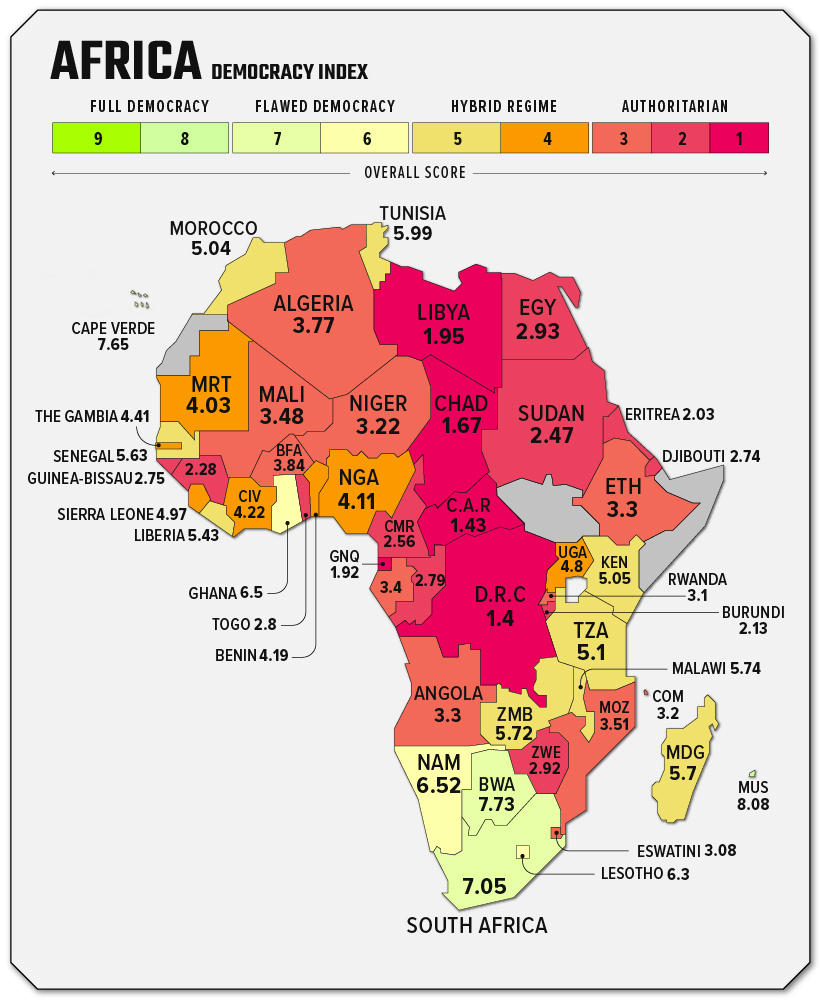
In North Africa, four countries are considered authoritarian regimes: Sudan, Egypt, Libya, and Algeria. Only Morocco and Tunisia fall into the hybrid regime classification.
Middle East and Central Asia
This region concentrates a substantial number of countries classified as authoritarian regimes. In fact, the region’s overall democracy score is now lower than what it was before the start of the Arab Spring in 2010.
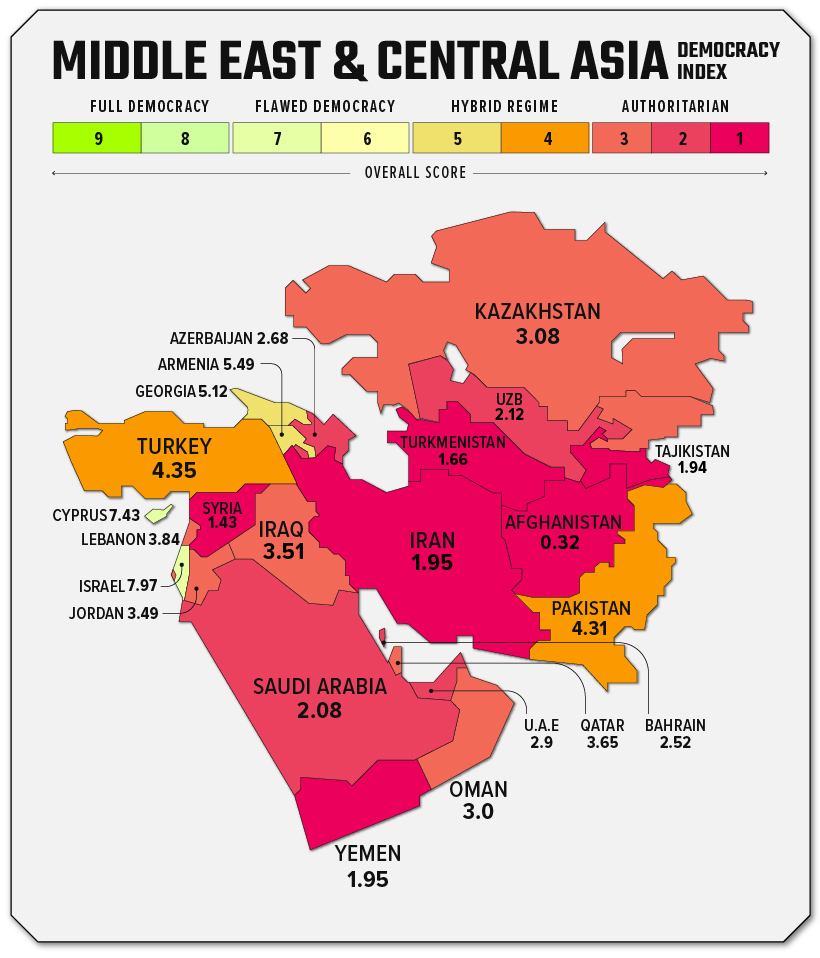
There are no countries falling under the category of full democracy in this region. Only Israel (7.97) and Cyprus (7.43) are considered flawed democracies. Turkey, Georgia, Armenia, and Pakistan fall under the category of hybrid regimes, and the rest of the countries in the region are considered authoritarian regimes.
East Asia and Oceania
This is broad region is full of contrasts. Aside from Western Europe, East Asia and Oceania contains the most full democracies: New Zealand, Taiwan, Australia, South Korea, and Japan. There are also a high number of countries that fall under the category of flawed democracies.
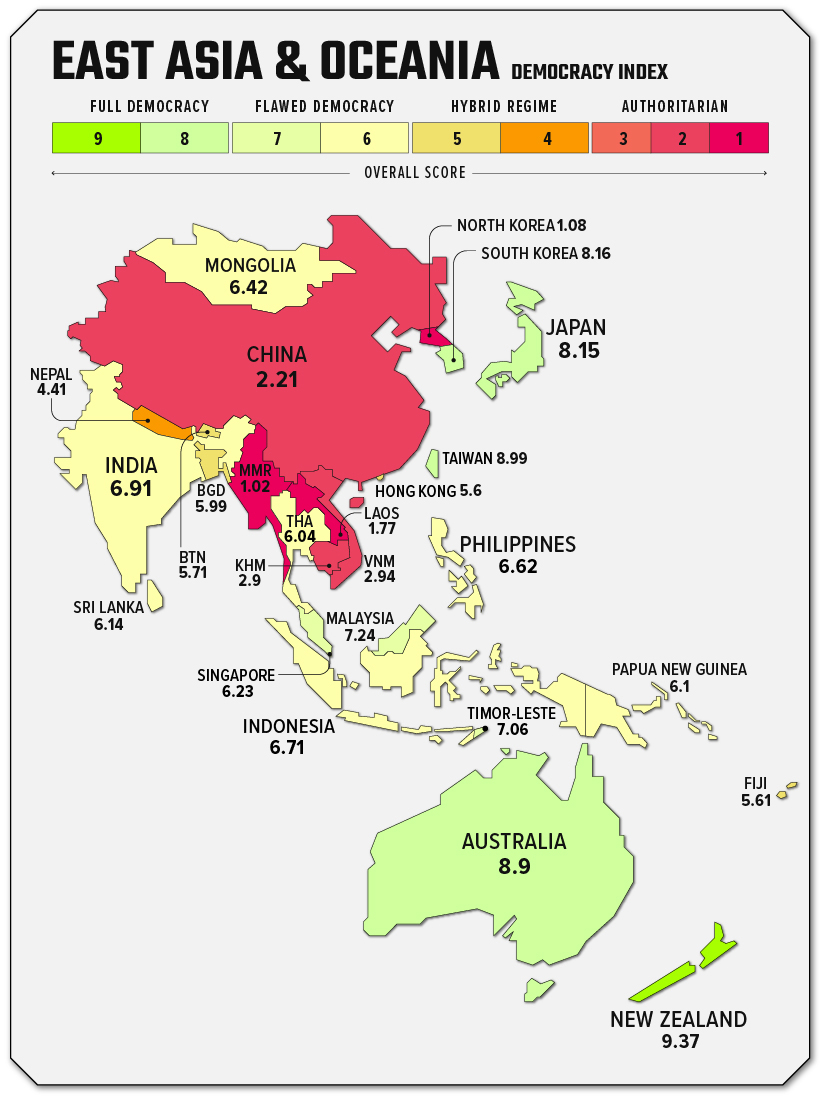
It’s worth noting that some of the most contentious geopolitical relationships are between neighbors with big differences in their scores: China and Taiwan, or North and South Korea are examples of this juxtaposition.
Decline in Global Democracy Levels
Two years after the world got hit by the pandemic, we can see that global democracy is in a downward trend.
Every region’s global score experienced a drop, with the exception of Western Europe, which remained flat. Out of the 167 countries, 74 (44%) experienced a decline in their democracy score.
As pandemic restrictions continue to be lifted, will democracy make a comeback in 2022?
United States
Charted: What Southeast Asia Thinks About China & the U.S.
A significant share of respondents from an ASEAN-focused survey are not happy about rising American and Chinese influence in the region.

What Southeast Asia Thinks About China & the U.S.
This was originally posted on our Voronoi app. Download the app for free on iOS or Android and discover incredible data-driven charts from a variety of trusted sources.
This chart visualizes the results of a 2024 survey conducted by the ASEAN Studies Centre at the ISEAS-Yusof Ishak Institute. Nearly 2,000 respondents were asked if they were worried or welcoming of rising Chinese and American geopolitical influence in their country.
The countries surveyed all belong to the Association of Southeast Asian Nations (ASEAN), a political and economic union of 10 states in Southeast Asia.
Feelings Towards China
On average, a significant share of respondents from all 10 countries are worried about rising influence from both the U.S. and China.
However, overall skepticism is higher for China, at 74% (versus 59% for U.S.).
| Country | Worried About Growing 🇨🇳 Influence | Welcome Growing 🇨🇳 Influence |
|---|---|---|
| 🇧🇳 Brunei | 58% | 42% |
| 🇰🇭 Cambodia | 66% | 34% |
| 🇮🇩 Indonesia | 57% | 43% |
| 🇱🇦 Laos | 68% | 32% |
| 🇲🇾 Malaysia | 56% | 44% |
| 🇲🇲 Myanmar | 95% | 5% |
| 🇵🇭 Philippines | 81% | 19% |
| 🇸🇬 Singapore | 74% | 26% |
| 🇹🇭 Thailand | 84% | 16% |
| 🇻🇳 Vietnam | 96% | 4% |
| Average | 74% | 27% |
The recently-cooled but still active territorial concerns over the South China Sea may play a significant role in these responses, especially in countries which are also claimants over the sea.
For example, in Vietnam over 95% of respondents said they were worried about China’s growing influence.
Feelings Towards America
Conversely, rising American influence is welcomed in two countries with competing claims in the South China Sea, the Philippines (69%) and Vietnam (55%).
| Country | Worried About Growing 🇺🇸 Influence | Welcome Growing 🇺🇸 Influence |
|---|---|---|
| 🇧🇳 Brunei | 73% | 27% |
| 🇰🇭 Cambodia | 58% | 42% |
| 🇮🇩 Indonesia | 73% | 27% |
| 🇱🇦 Laos | 79% | 21% |
| 🇲🇾 Malaysia | 68% | 32% |
| 🇲🇲 Myanmar | 45% | 55% |
| 🇵🇭 Philippines | 32% | 69% |
| 🇸🇬 Singapore | 37% | 63% |
| 🇹🇭 Thailand | 80% | 20% |
| 🇻🇳 Vietnam | 45% | 55% |
| Average | 59% | 41% |
Despite this, on a regional average, more respondents worry about growing American influence (59%) than they welcome it (41%).
Interestingly, it seems almost every ASEAN nation has a clear preference for one superpower over the other.
The only exception is Thailand, where those surveyed were not a fan of either option, with 84% worried about China, and 80% worried about the U.S.
-

 Culture6 days ago
Culture6 days agoThe World’s Top Media Franchises by All-Time Revenue
-

 Science2 weeks ago
Science2 weeks agoVisualizing the Average Lifespans of Mammals
-

 Brands2 weeks ago
Brands2 weeks agoHow Tech Logos Have Evolved Over Time
-

 Energy2 weeks ago
Energy2 weeks agoRanked: The Top 10 EV Battery Manufacturers in 2023
-

 Countries2 weeks ago
Countries2 weeks agoCountries With the Largest Happiness Gains Since 2010
-

 Economy2 weeks ago
Economy2 weeks agoVC+: Get Our Key Takeaways From the IMF’s World Economic Outlook
-

 Demographics1 week ago
Demographics1 week agoThe Countries That Have Become Sadder Since 2010
-

 Money1 week ago
Money1 week agoCharted: Who Has Savings in This Economy?




